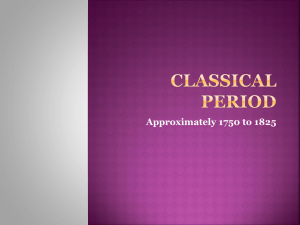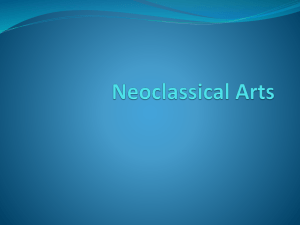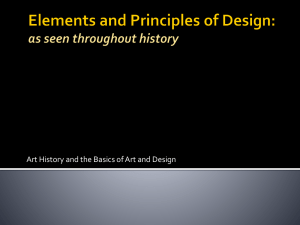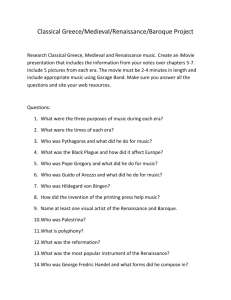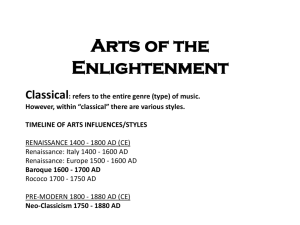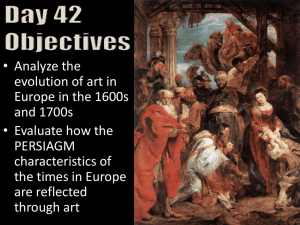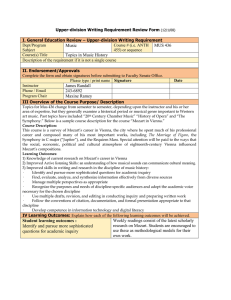Jefferson and David
advertisement
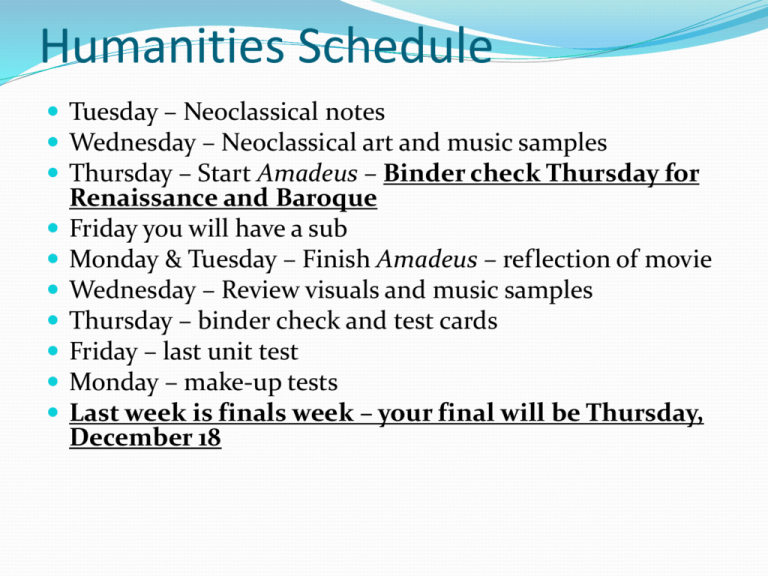
Humanities Schedule Tuesday – Neoclassical notes Wednesday – Neoclassical art and music samples Thursday – Start Amadeus – Binder check Thursday for Renaissance and Baroque Friday you will have a sub Monday & Tuesday – Finish Amadeus – reflection of movie Wednesday – Review visuals and music samples Thursday – binder check and test cards Friday – last unit test Monday – make-up tests Last week is finals week – your final will be Thursday, December 18 Renaissance and Baroque Binder Check – On Thursday Renaissance notes with summary Renaissance samples (visual and music) Renaissance worksheet packet (from day with sub – 11-6) Baroque notes with summary Baroque samples (visual and music) Neo-classic Era Basics Neo=new “Age of Reason” – intellectual movement – ideas of Greece and Rome were inspiration Marked by rationality, ethics, aesthetics, and knowledge Get away from superstition (magic), irrationality, and tyranny of dark ages Enlightenment – framework for American and French revolution Continued Birth of capitalism, socialism, liberalism, and fascism Arts important way of spreading knowledge and serving the state’s needs State created arts academies – served the state’s needs and ideas – created qualifications and diplomas Women recognized in the arts for first time Public museums and art galleries created Thomas Jefferson Promoted Neo-Palladian style architect (Andrea Palladio – principles of classic Roman architecture) Monticello Capitol Building Monticello Capitol Building Neoclassicism in visual art Get away from Baroque Purity of Roman art/idealism of Greek art Sharp colors Clean lines (no Sfumato) Chiaroscuro (less though) Use of perspective Look of artificial light, almost like the theatre Jacques-Louis David French Inspired by Greeks and Romans Many works were based on ancient history/mythology Official artist of the French revolution/Napoleon’s court Painted many portraits of revolutionary leaders Created costumes to be worn by citizens of the republic Later self exiled (Louis XVIII) The Classical Music Period (1720-1830) Classical Music • Polyphony replaced by homophonic (melody supported by system of harmony) • Movement centered in/around Vienna • Begins in 1750’s and 60’s • Reached maturity in 70’s and 80’s – around the time of the American & French revolutions Mozart • First symphony (musical work made up of 4 movements separated by silence) at age 8 • Amadeus means “loved by God” • Austrian Emperor Joseph II accused his music of “too many notes” • Spread his reputation in Vienna by publishing, playing the piano and having an opera performed in 1782 (the first one you will see in the movie) Mozart • Composed 15 piano concertos (composition for an orchestra and soloist) by 1786 • Served as composer and soloist in his works • Unable to finish his Requiem • Possible causes of death – Flu, Mercury poisoning (medicine), Kidney illness, Rheumatic fever • Buried in a Vienna suburb with little ceremony and in an unmarked grave (even the second one he was buried in) Haydn • Trained as a choirboy and taken to St. Stephen’s Cathedral, Vienna, in mid 1700’s • Became freelance musician and accompanyist • Played violin and keyboard • Wrote sacred music, music for theatre comedies, and chamber music • Seen as the “father of the symphony and string quartet” – did not originate them • At his funeral in 1809 Mozart’s Requiem was performed Beethoven • Exact date of birth unknown (likely 12/16/1770) • Father gave instruction in piano, violin, and viola • First public concert was on March 26, 1778 at age 7 (same day as his death 49 years later) • 1802 – found out his impaired hearing was incurable and would worsen Beethoven • Became very productive despite hearing impairment • Aristocracy of Vienna supported him generously and were tolerant of his rude & insensitive manners, careless appearance, and towering rages • From end of 1790’s, he was no longer dependent on patronage for income • Sometimes took several years to refine an idea before satisfied Beethoven • Ideas usually written in sketchbooks which he constantly carried • Death in 1827 – said that 10,000 people were at his funeral • Became public figure before death – unlike any musicians before • Bridged classical of Mozart and Haydn with Romantic period that followed Moliere and Swift Making fun of current events or social structures through irony, sarcasm and wit Makes fun of moral and social views “Tongue-in-cheek” humor French actor and playwright Master of Satire Dance and drama were very important to the French aristocracy/helped him promote his art Established his own acting troupe in the court of Louis XIV (1660) Also used physical humor inspired by Commedia dell’arte Used 5 act development as seen in Greek and Renaissance (Shakespeare) Superstition – he collapsed during a presentation of The Imaginary Invalid and died later in his home – was wearing yellow on stage – seen as bad luck by some actors to wear yellow costumes on stage Summary Write a 5-6 sentence summary for Neo-Classical Art
